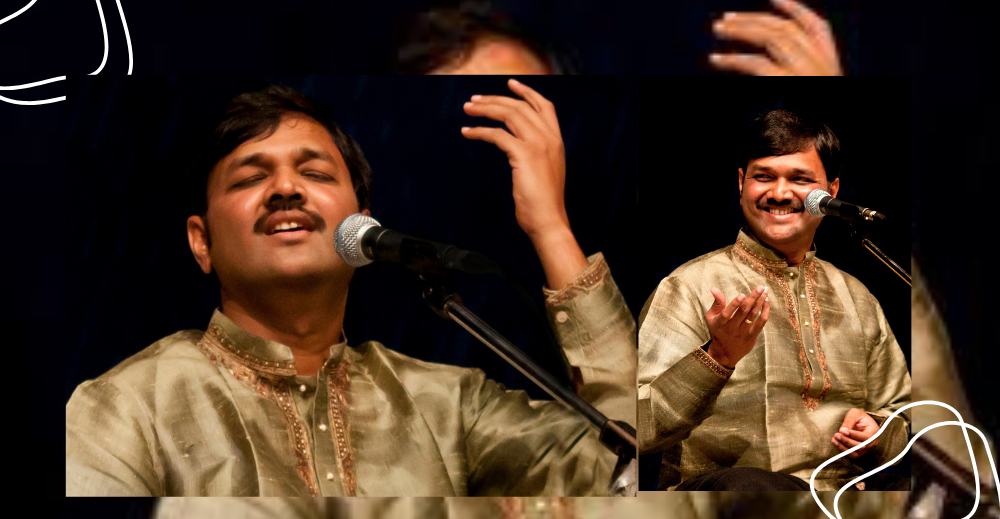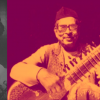As a 3 year old child, he perfectly reproduced the renditions of his grandmother. As he approached 11, in his solo stage performance he sang for two hours continuously before a stunned audience who couldn’t believe their eyes and ears. A Child who got the title of “wonder boy” by the likes of Bhimsen joshi, Ganubai Hangal, Hirabai Badodkar and Vasant Rao Deshpande as they advised him to dedicate his life to singing. That child grew up to become famous by the name of Pandit Sanjeev Abhyankar.
Born on 5 Oct 1969, Sanjeev belongs to the famous Mewati Gharana. Sanjeev was born and brought up in an atmosphere of music. His mother Dr. Sobha Abhyankar was a classical singer. Sanjeev showed the traits of a great singer at a very early age and realizing the latent potential of their son, his parents decided to train him in classical music. He started his formal training under his mother and simultaneously received guidance from his mother’s Guru Pandit Gangadharbua Pimple khade.
Sanjeev gave his first stage performance at an age of 11. He crooned and wove magic for two hours continuously which earned him the name of ‘wonder boy’. In the mean time, Shobha Abhyankar had become the disciple of Pandit Jasraj. She thought, Sanjeev should also learn the nuances of classical music from Pandit Jasraj and requested him to accept Sanjeev as his disciple . After listening to his songs, Jasraj took him in as his student. It was a turning point in Sanjeev’s life.
Sanjeev was trained by Pandit Jasraj under the sacred Guru Shishya tradition. But his actual learning came from giving on stage vocal support to Panditjee while playing Tanpura. Sanjeev was associated with Panditjee for 10 years. In those days, Panditjee stayed mostly out of Mumbai for his concerts and Sanjeev always accompanied him. He learnt most from his Guru while giving him vocal support. Later he also performed in Jugalbandis with his Guru.
Sanjeev says, while teaching one to one, Guru may not be fully focused but when one has to perform before an audience, every artist brings out the best out of him. In these 10 years, he accompanied Panditjee in at least 400 concerts. In the words of Sanjeev, “It was like watching Sachin play his 400 best innings by standing on the other side of the wicket.” A word of praise from his Guru was the biggest award for Sanjeev.
There is an interesting story during his stint with Panditjee. In 1991, at one of Panditjee’s concerts in Nagpur, Sanjeev was playing Tanpura, by then Sanjeev already had recorded many songs and had become a full fledged professional singer. It was difficult for him to sit quietly playing Tanpura while inhibiting his singing skills. Before crooning Raag Miya Malhar, Panditjee asked him to sit quietly in the first Raga, and to support him in the second one. Under Guru’s order, sanjeev patiently played Tanpura for next 45 minutes. Meanwhile, Panditjee observed the discomfort evident on Sanjeev’s face. When the concert was concluding, Panditjee gestured him to follow on his Taans (notes) with double speed. Sanjeev was eagerly waiting for this moment. He exploded and sang back to back in 4 cycles making the auditorium burst with the claps of charged audiences. Had it been some other Guru, he could have made him sing 3-4 similar excursions but it was the greatness of Panditjee that he observed, with the Dhrut Taans (fast notes) of Sanjeev, the raga has reached its climax. He finished the singing at that point only, kept his Surmandal aside and embraced Sanjeev.
Sanjeev was a child prodigy. He effortlessly sailed through three octaves ( saptak) and complex taans. While learning from Panditjee, Sanjeev often added his own dimensions in his teachings, to this Panditjee advised him,” You are here to understand my perspective of music. So, you should learn from my experiences and observation. Once your training is over then you can definitely add on your own. From 1994, Sanjeev started giving his solo performances , as a true student of music he compares his renditions with teachings of his Guru and if it is in sync with his perspective than he kept it and if he discovered something refreshingly new he adorned it . It is the greatness of Panditjee that if Sanjeev sings something different today, he whole-heartedly welcomes them.
While singing, Sanjeev has an enchanting childlike smile on his face. Music is a powerful medium to connect with God and when Sanjeev gets into devotional mode, he takes his audience to another world.
Along with Khayal Gayaki, Sanjeev Abhayankar has also given his voice to Thumris, Bhajan and Abhangs. He has recorded songs for many reputed labels including HMV, Times Music, Sony Music, Navras Records, Music Today, Ninad, and Fountain Music. He has also done playback singing for films like Maachis, Nidaan, Sansodhan, Dil Pe Mat Le Yaar and Banaras. In 1998, he received National award for the best male playback singer for film Godmother.
Sanjeev has exclusively performed in more than 200 cities around the world. He is widely popular among the listeners of Hindustani classical music in America, Canada, Australia, Europe and Middle-East. Undoubtedly, he is a shining star among the new breed of classical singers. He is an inspiration for the budding classical singers; his music has aroused curiosity among new listeners and singers as well. We wish him more success and that he keeps mesmerizing us with his melodious voice.




